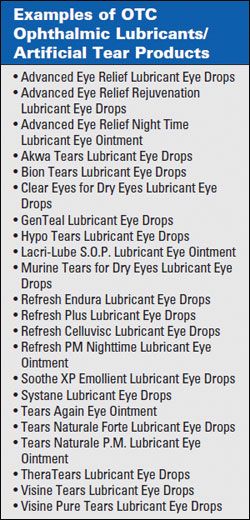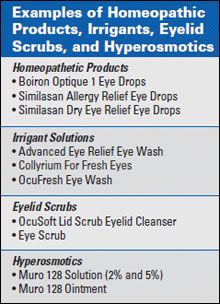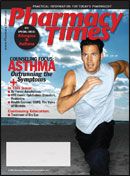Publication
Article
Pharmacy Times
Ophthalmic Disorders
Many eye disorders are appropriate for self-treatment, and patients should be thoroughly counseled on OTC product selection, proper administration, and duration of use.
Ms. Terrie is a clinical pharmacy writer based in Haymarket, Virginia.

Many ophthalmic disorders that areamenable to self-treatment are thoseinvolving the eyelids and adjacentareas, such as contact dermatitis andblepharitis.1 Some disorders that affectthe eye surface can be self-treated aswell, including dry eye, allergic conjunctivitis,viral conjunctivitis, diagnosedcorneal edema, minor ocular irritation,as well as cleaning or lubricating of artificialeyes.1
Episodes of dry eye and allergic conjunctivitisare the most common ophthalmicconditions for which patientselect to use OTC ophthalmic productsfor prevention and treatment. Althoughsome ophthalmic conditions are amenableto self-treatment, it is importantfor pharmacists to encourage patientswith more serious conditions to seekimmediate medical attention to preventfurther complications.
A variety of OTC ophthalmic productsare currently on the market, includingocular lubricants (artificialtear solutions and nonmedicated ointments),ocular decongestants, an ocularantihistamine/mast cell stabilizer,and products containing a combinationof decongestants and antihistaminesfor the management and treatmentof minor and self-limiting ophthalmicconditions, such as dry eye and allergicconjunctivitis. Eyelid scrubs fortreating blepharitis, ophthalmic irrigantsolutions for removing loose foreignsubstances from the eye (eg, lint anddust), and hyperosmotics for diagnosedcorneal edema are also available.1
Nonmedicated Ointments
The primary ingredients in OTC ophthalmicointments are white petrolatum,which acts as a lubricant andan ointment base; mineral oil, whichassists the ointment in melting at bodytemperature; and lanolin, which aids inthe absorption of water-soluble medicationsand also inhibits evaporation.1
Nonmedicated ointments are consideredto be the mainstay of treatingminor ophthalmic disorders, such asdry eye and minor eye irritation.1 Ingeneral, these products are to be usedtwice daily but can be administeredmore often, depending on the patient’sneeds.1 Patients may complain aboutblurred vision when using ophthalmicointments; therefore, many patientsprefer to administer these ocular lubricantsat bedtime to assist in keepingthe ocular area moist during sleep andimprove the symptoms associated withdry eye upon waking.1

Table 1
Artificial Tears
Ocular lubricants, such as artificialtear solutions, contain preservativesand inorganic electrolytes to achievetonicity and sustain pH, as well aswater-soluble polymeric systems.1 Preservative-free products are available as well. These products typicallycontain enhancing agents, such as carboxymethylcellulose, glycerin, hydroxyethyl cellulose, hydroxypropyl methylcellulose, methylcellulose, polycarbophil, polyethylene glycol 400, polysorbate 80, or polyvinyl alcohol.1
Artificial tear substitutes provide a barrier function and help to improve the first-line defense at the level ofconjunctival mucosa.1 These products help to dilute various allergens and inflammatory mediators that may be present on the ocular surface and assist in flushing the ocular surface of these agents.1 In general, artificial tears are instilled once or twice daily, typically in the morning and again at bedtime. Patients should be reminded that artificial tear products containing preservatives may cause allergic reactions and should be immediately discontinued if a reaction occurs.1 Artificial tear products can be refrigerated to provide additionalsoothing comfort upon instillation, are considered very safe, and can be used as often as needed.
Topical Decongestants
Examples of OTC topical ophthalmic decongestants currently on the market include phenylephrine, naphazoline, tetrahydrolazine, and oxymetazoline. Naphazoline, tetrahydrolazine, and oxymetazoline are classified as imidazoles.Phenylephrine acts primarily on alpha adrenergic receptors of the ophthalmic vasculature to constrict conjunctival vessels, therefore decreasing eye redness.1 Like phenylephrine, the imidazole decongestants are used to constrict conjunctival blood vessels. Naphazoline has demonstrated efficacy in decreasing tearing and pain associated with superficial inflammationof the ocular area.1 Topical useof oxymetazoline has been shown toimprove the symptoms of burning, itching,and tearing associated with allergicconjunctivitis.1
Decongestants are usually applied1 or 2 drops up to 4 times a day, butare often overused by many patients.Oxymetazoline is a longer acting agentthat is generally administered twicedaily. Eye irritation and loss of efficacyis fairly common with the overuse oftopical decongestants. Adverse effectsof topical vasoconstrictors includeburning and stinging after administration.The primary contraindication isnarrow-angle glaucoma, as these agentsproduce a mild papillary dilation.1 Commonlyused OTC decongestant ophthalmicdrops include naphazoline hydrochloride0.012%, 0.02%, and 0.03%;tetrahydrozaline 0.05%; phenylephrinehydrochloride 0.12%; and oxymetazolinehydrochloride 0.025%.

Table 2
When used as directed, ocular decongestantstypically do not produce eitherocular or systemic adverse effects.1These products are indicated for use upto 4 times a day, and their therapeuticeffects last approximately 2 hours. Inorder to obtain relief throughout theday, some patients tend to use dropsmore often than recommended, whichcan lead to adverse effects. The mostcommon adverse effects associatedwith the use of ocular decongestantsare rebound erythema and congestionof the conjunctiva, in which the conjunctivalvessels become increasinglymore dilated with continued use ofthese agents.1 Manufacturers recommendthat these products be used forno more than 72 hours.
Patients with narrow-anterior chamberor narrow-angle glaucoma shouldnot use ophthalmic decongestantsbecause of the risk of angle closureglaucoma, and these patients shouldbe referred to their ophthalmic healthcare provider.1 Ocular decongestantsshould be used cautiously in individualswith hypertension, arteriosclerosis,other cardiovascular diseases, anddiabetes. In addition, cardiovascularadverse effects also are possible if oculardecongestants are used in individualswith hyperthyroidism.1 Women whoare pregnant should avoid using oculardecongestants when possible.
Ocular Antihistamines
In 2006, the FDA approved ketotifen0.025% ophthalmic solution from prescriptionto OTC status, and it becameavailable to patients in 2007. Ketotifenis the only OTC ophthalmic antihistamineproduct that relieves ocular itchingwithout the use of a decongestant.Ketotifen is a benzocycloheptathiophenederivative that has been used formany years. It is classified as a noncompetitiveH1-receptor-antagonist andmast cell stabilizer that inhibits releaseof mediators from cells involved inhypersensitivity reactions.2-4
Ketotifen is approved for use in individuals3 years of age and older andis classified as pregnancy Category C.This agent is indicated for the temporaryrelief of itchy eyes from exposureto ragweed, pollen, grass, animal hair,and dander.2-4 The recommended dosageis 1 drop to the affected eye(s)every 8 to 12 hours but no more thantwice daily. Common adverse reactionsinclude headache, dry eyes, and rhinitis.Ketotifen is not indicated for treatmentof contact lens–related inflammation.Patients should be instructed towait at least 10 minutes before insertingtheir contact lenses after instillation ofketotifen.2-4
Other OTC ocular antihistaminesinclude pheniramine maleate and antazolinephosphate available in combinationwith a decongestant. Pheniraminehas been shown to have little effect onintraocular pressure, whereas antazolinecan increase ocular pressure slightly.1
Conclusion
Pharmacists can assist patients in theproper selection of OTC ophthalmicproducts (Tables 1 and 2), as well asensure that patients clearly understandhow to administer these medicationsproperly. Prior to recommending anyof these products, pharmacists shoulddetermine if self-treatment is appropriate and refer patients to seek medicalcare when warranted.
Patients who elect to use ophthalmicdecongestants should be remindedthat excessive use can cause reboundcongestion of the conjunctiva. Patientswho are also using prescription ophthalmicmedications should always consulttheir ophthalmologist prior to usingOTC ophthalmic products.
In addition, patients should be counseledthoroughly on the appropriate useand duration of these products and theadverse effects associated with theiruse. They should be reminded to washtheir hands prior to administration, aswell as avoid touching the applicator toprevent contamination. Individuals whowear contact lenses should be advisednot to wear their lenses until the ophthalmiccondition improves. Patientswith severe eye pain, those exhibitingsigns and symptoms of ophthalmicinfections, those with blurred vision,those with exposure of eyes to chemicals,and those who have had blunttrauma to the eye should seek immediatemedical care.

Table 3
References
- Fiscella R, Jensen M. Ophthlamic Disorders. In: Berardi R, Newton G, McDermott JH, et al, eds. Handbook of Nonprescription Drugs. 15th ed. Washington, DC: American Pharmacists Association; 2006:577-603.
- Alaway Antihistamine Drops [product information]. Bausch & Lomb Web site. www.bausch.com/en_US/consumer/visioncare/product/drops/alaway_con.aspx. Accessed January 29, 2009.
- Zaditor [product information]. Novartis Web site. www.zaditor.com/info/about/zaditor-eye-drops.jsp. Accessed January 30, 2009.







